Family name: Marantaceae Petersen
Synonym(s): [none]
Common name(s): prayer-plant family
*Number of genera/species: 29/525
List of genera records in GRIN-Global
fruit or seed
Fruit dehiscent, loculicidalloculicidal:
type of capsular dehiscence, opening longitudinally through the locules (compare septicidal)
 capsulecapsule:
capsulecapsule:
a dry, dehiscent fruit formed by two or more carpels
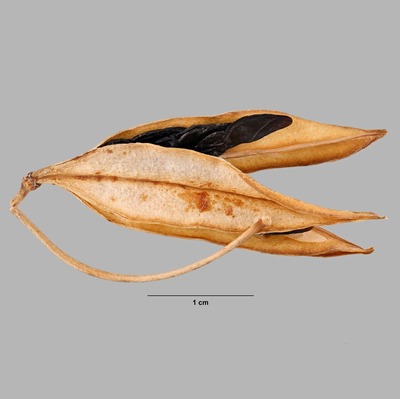 or sometimes indehiscentindehiscent:
or sometimes indehiscentindehiscent:
not opening on its own, as in a fruit
 , berry (fleshy - Sarcophyrnium, leathery leathery:
, berry (fleshy - Sarcophyrnium, leathery leathery:
texture—moderately thick, tough, and very pliable
- Thaumatococcus), 6–20 mm long, globoseglobose:
3D shape—more or less spherical
 to trigonoustrigonous:
to trigonoustrigonous:
3D shape—having three faces that meet at distinct angles; triangular in outline
, angledangled:
2D shape—having sides that meet at acute or obtuse angles
in transectiontransection:
a cross section; representing a plane made by cutting across an organ at a right angle to its length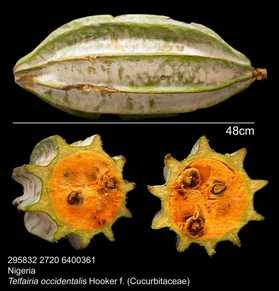 , 1–3 seeded, sometimes with persistent sepalssepals:
, 1–3 seeded, sometimes with persistent sepalssepals:
a member of the outer envelope of a flower (calyx)
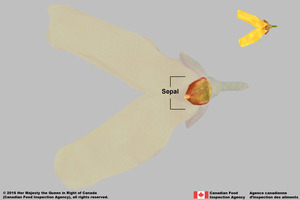 . Pericarppericarp:
. Pericarppericarp:
fruit wall or fruit coat
brown, white, green, orange, or red, shinyshiny:
uniformly reflecting a high proportion of incident light at all angles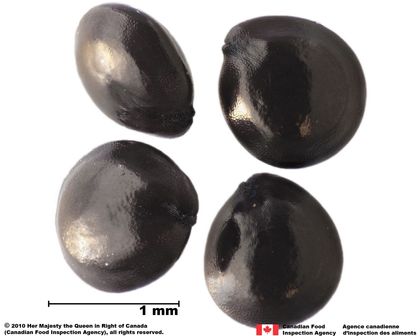 , indurateindurate:
, indurateindurate:
texture—hardened or stony; yielding under strong pressure; not deformable without internal structural disruption
or fleshyfleshy:
texture—fairly firm and dense, juicy or at least moist, and easily cut
, sometimes pubescentpubescent:
surface relief—bearing hairs
, smooth, spinyspiny:
having slender, stiff, sharp projections oriented in the general plane of the structure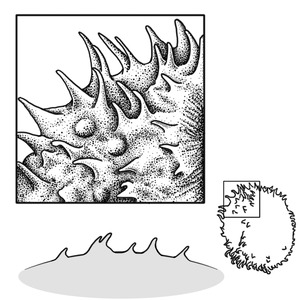 in Coeppertia, roughenedroughened:
in Coeppertia, roughenedroughened:
texture—having a small, stout, stiff, more or less acute protrusions
in Trachyphyrynium, or papillosepapillose:
surface relief—bearing minute, distinct, broad-based projections, tapering to a rounded apex in some Calathea spp. In Thaumatococcus, berriesberries:
in some Calathea spp. In Thaumatococcus, berriesberries:
an indehiscent, fleshy fruit with one or a few to many seeds. The flesh may be homogenous throughout. Or, if the outer part is hard, firm, or leathery, referred to as an hesperidium. Septa are present in some, and the seeds may be arillate or with a fleshy testa. are large, leatheryleathery:
are large, leatheryleathery:
texture—moderately thick, tough, and very pliable
, winged, and with mucilaginousmucilaginous:
resembling mucilage; moist and sticky
endocarps. In Thalia and Halopegia, fruit is caryopsis-like, indehiscentindehiscent:
not opening on its own, as in a fruit
 with a thinthin:
with a thinthin:
having or being of relatively little depth
paperypapery:
texture—papyraceous, chartaceous; very thin, pliable, and readily torn; like paper
or membranousmembranous:
texture—extremely thin, pliable, and fairly tough
fruit wall and 1-seeded.
Seed angularangular:
2D shape—having sides that meet at acute or obtuse angles
to globoseglobose:
3D shape—more or less spherical
 , compressedcompressed:
, compressedcompressed:
flattened; in grasses, used to denote compression (not necessarily flattened) either laterally or dorsiventrally
in transectiontransection:
a cross section; representing a plane made by cutting across an organ at a right angle to its length , often large (up to 20 mm long), with operculumoperculum:
, often large (up to 20 mm long), with operculumoperculum:
a dehiscent cap (or lid) of a seed or fruit that opens during germination or dehiscence
 and micropylar collarmicropylar collar:
and micropylar collarmicropylar collar:
collar shaped tissue at micropyle
. Seed coat blue, brown, black, or gray, shinyshiny:
uniformly reflecting a high proportion of incident light at all angles , encrusted in phytomelanphytomelan:
, encrusted in phytomelanphytomelan:
carbonaceous, opaque material that usually covers the seed coat to give it a black appearance, common in certain monocot families
, smooth, groovedgrooved:
surface relief—linear depressions that may be single or form a series of grooves over the surface , reticulatereticulate:
, reticulatereticulate:
surface relief—netted, raised walls or concave grooves forming a net-like surface pattern with flat, concave, or convex interspaces , wrinkledwrinkled:
, wrinkledwrinkled:
surface relief—shallow, irregular folds and furrows covering the surface; appearing overall though crumpled and then spread out , or wartywarty:
, or wartywarty:
surface relief—distinct, rounded projections that are large relative to the fruit size; tuberculate, verrucose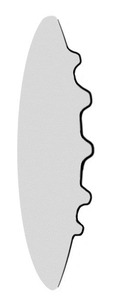 , sometimes pubescentpubescent:
, sometimes pubescentpubescent:
surface relief—bearing hairs
. Seeds from capsulescapsules:
a dry, dehiscent fruit formed by two or more carpels
 have white, fleshyfleshy:
have white, fleshyfleshy:
texture—fairly firm and dense, juicy or at least moist, and easily cut
arilsarils:
(broad sense) appendicular structure that wholly or partly envelops a seed and is produced from or a modification of the funicle, raphe, or outer integument; usually fleshy or pulpy, sometimes spongy or tufted-capillate, often brightly colored
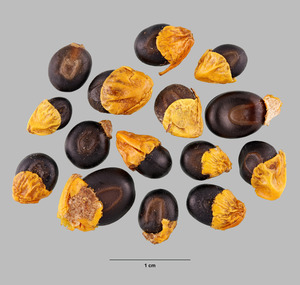 adnate to the hilumhilum:
adnate to the hilumhilum:
on seeds, the scar indicating where the funiculus was attached; on grass caryopses, the scar visible on the outer caryopsis surface revealing where the seed is attached on the inner fruit wall surface; or in Asteraceae cypselae, the scar visible on the pericarp revealing where the fruit was attached to the receptacle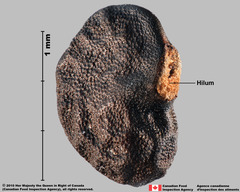 , which aids in seed expulsion. Seeds from indehiscentindehiscent:
, which aids in seed expulsion. Seeds from indehiscentindehiscent:
not opening on its own, as in a fruit
 fruits lack obvious arilsarils:
fruits lack obvious arilsarils:
(broad sense) appendicular structure that wholly or partly envelops a seed and is produced from or a modification of the funicle, raphe, or outer integument; usually fleshy or pulpy, sometimes spongy or tufted-capillate, often brightly colored
 except in Thaumatococcus in which the arilsarils:
except in Thaumatococcus in which the arilsarils:
(broad sense) appendicular structure that wholly or partly envelops a seed and is produced from or a modification of the funicle, raphe, or outer integument; usually fleshy or pulpy, sometimes spongy or tufted-capillate, often brightly colored
 appear as membranousmembranous:
appear as membranousmembranous:
texture—extremely thin, pliable, and fairly tough
sheets surrounding the seed coat.
Embryo well developed, usually annularannular:
3D shape—forming a ring
 or horseshoe-shapedhorseshoe-shaped:
or horseshoe-shapedhorseshoe-shaped:
3D shape—relatively slender and strongly compressed, the whole strongly curved over its length in a plane perpendicular to the
direction of compression and forming an incomplete circle, the ends somewhat straighter than the rest and parallel or nearly so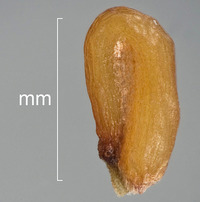 , sometimes J-shaped or straight, and surrounding copious, mealymealy:
, sometimes J-shaped or straight, and surrounding copious, mealymealy:
loose, dry, and disintegrating in finely granular
pieces like meal or flour
perisperm. A canal extends through the perispermperisperm:
seed nutritive tissue comparable to the endosperm, but derived from the nucellus (maternal tissue)
from the funicular end to where the embryo bends. The canal is simplesimple:
fruit formed from a single flower with one pistil, solitary carpel or several fused carpels
(Ischnosiphon, Monotagma), laterally dilated (Calathea, Haumania), distally branched (Donax, Hypselodelphys, Marnata, Myrosma, Monophyllanthe), or branched from the base (Thalia).
| Fruit | |
| Type | capsule, berry |
| Size range | 6–20 mm long |
| Shape(s) | conical, ellipsoidellipsoid: 3D shape—elliptic , globoseglobose: 3D shape—more or less spherical  , oblongoblong: , oblongoblong:2D shape—much longer than broad with nearly parallel sides, corners are rounded  , trigonoustrigonous: , trigonoustrigonous:3D shape—having three faces that meet at distinct angles; triangular in outline , teardrop-shaped |
| Texture | indurate, fleshyfleshy: texture—fairly firm and dense, juicy or at least moist, and easily cut , chartaceouschartaceous: =papery, papyraceous , leathery |
| Surface relief | smooth or roughenedroughened: texture—having a small, stout, stiff, more or less acute protrusions , spinyspiny: having slender, stiff, sharp projections oriented in the general plane of the structure  , papillate , papillate |
| Color(s) | white, brown, red, green, orange |
| Unique features | Usually 1–3 seeded capsulescapsule: a dry, dehiscent fruit formed by two or more carpels  , sometime berriesberry: , sometime berriesberry:an indehiscent, fleshy fruit with one or a few to many seeds. The flesh may be homogenous throughout. Or, if the outer part is hard, firm, or leathery, referred to as an hesperidium. Septa are present in some, and the seeds may be arillate or with a fleshy testa.  or caryopsis-like 1-seeded fruits with large seeds usually with basalbasal: or caryopsis-like 1-seeded fruits with large seeds usually with basalbasal:at or pertaining to the point of attachment; (of embryo) embryo occupies one end of the seed arilaril: (broad sense) appendicular structure that wholly or partly envelops a seed and is produced from or a modification of the funicle, raphe, or outer integument; usually fleshy or pulpy, sometimes spongy or tufted-capillate, often brightly colored  (or pulp) and operculumoperculum: (or pulp) and operculumoperculum:a dehiscent cap (or lid) of a seed or fruit that opens during germination or dehiscence  encrusted in phytomelanphytomelan: encrusted in phytomelanphytomelan:carbonaceous, opaque material that usually covers the seed coat to give it a black appearance, common in certain monocot families . |
| Seed | |
| Size range | 3–20 mm long |
| Shape(s) | ellipsoid, globoseglobose: 3D shape—more or less spherical  , triangulartriangular: , triangulartriangular:2D shape—three relatively straight sides with distinct corners; more angular than teardrop-shaped  , polygonal , polygonal |
| Surface relief | reticulate, wrinkledwrinkled: surface relief—shallow, irregular folds and furrows covering the surface; appearing overall though crumpled and then spread out  , wartywarty: , wartywarty:surface relief—distinct, rounded projections that are large relative to the fruit size; tuberculate, verrucose  , grooved , grooved |
| Color(s) | blue, brown, black, gray |
| Unique features | Large, phytomelanphytomelan: carbonaceous, opaque material that usually covers the seed coat to give it a black appearance, common in certain monocot families encrusted seeds with curvedcurved: (of embryo) linear embryo is curved into an arch or horseshoe with the ends far apart 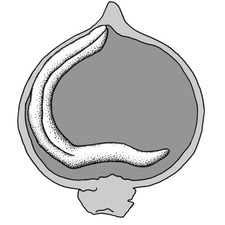 embryos (to annularannular: embryos (to annularannular:3D shape—forming a ring  ) with a canal that extends through perispermperisperm: ) with a canal that extends through perispermperisperm:seed nutritive tissue comparable to the endosperm, but derived from the nucellus (maternal tissue) . Shape of canal is diagnostic to one or more genera. |
| Other | |
| Embryo | well-developed, usually annularannular: 3D shape—forming a ring  or horseshoe-shapedhorseshoe-shaped: or horseshoe-shapedhorseshoe-shaped:3D shape—relatively slender and strongly compressed, the whole strongly curved over its length in a plane perpendicular to the direction of compression and forming an incomplete circle, the ends somewhat straighter than the rest and parallel or nearly so  , sometimes J-shaped or straight , sometimes J-shaped or straight |
| Nutritive tissuenutritive tissue: tissue within the seeds that nourishes the developing embryo; such as endosperm, perisperm, or chalazosperm in angiosperms; megagametophyte in gymnosperms |
copious, mealymealy: loose, dry, and disintegrating in finely granular pieces like meal or flour perisperm |
Tropics except Australia.

Distribution map courtesy of Angiosperm Phylogeny Website.
Baskin and Baskin 2021Baskin and Baskin 2021:
Baskin C and Baskin J. 2021. Relationship of the lateral embryo (in grasses) to other monocot embryos: A status up-grade. Seed Science Research 31 (3): 199-210. doi:10.1017/S0960258521000209; Dahlgren et al. 1985Dahlgren et al. 1985:
Dahlgren RMT, Clifford HT, and Yeo PF. 1985. The families of the monocotyledons: structure, evolution, and taxonomy. Springer-Verlag, Berlin. 520 pp.; Flora of North America Editorial Committee 1993+Flora of North America Editorial Committee 1993+:
Flora of North America Editorial Committee, eds. 1993+. Flora of North America North of Mexico [Online]. 22+ vols. Flora of North America Association, New York and Oxford. Accessed January-December 2021. URL: http://beta.floranorthamerica.org.; Kirkbride et al. 2006Kirkbride et al. 2006:
Kirkbride JH, Jr, Gunn CR, and Dallwitz MJ. 2006. Family guide for fruits and seeds, vers. 1.0. Accessed September 2020ndash;January 2022. URL: https://nt.ars-grin.gov/seedsfruits/keys/frsdfam/index.cfm .; Kubitzki et al. 1990+Kubitzki et al. 1990+:
Kubitzki K et al., eds. 1990+. The families and genera of vascular plants. 7+ vols. Berlin etc.; Milne-Redhead 1952Milne-Redhead 1952:
Milne-Redhead E. 1952. Marantaceae. In: Turrill WB and Milne-Redhead E, eds. Flora of Tropical East Africa. Vol 106. Crown Agents for the Colonies, London UK.; Stevenson and Loconte 1995Stevenson and Loconte 1995:
Stevenson DW and Loconte H. 1995. A cladistic analysis of monocot families. In: Rudall PJ, Cribb PJ, Cutler DF, and Humphries CJ, eds. Monocotyledons: Systematics and Evolution. Royal Botanic Gardens, Kew.; Takhtajan 2009Takhtajan 2009:
Takhtajan A. 2009. Flowering plants: Second edition. Springer Nature, Switzerland. 871 pp.; Watson and Dallwitz 1992+Watson and Dallwitz 1992+:
Watson L and Dallwitz MJ. 1992+. The families of flowering plants: descriptions, illustrations, identification, and information retrieval. Version: 6th Accessed September 2020-September 2022. URL: delta-intkey.com; Zhengyi et al. 2004+Zhengyi et al. 2004+:
Zhengyi W, Raven PH, and Deyuan H. 2004+. Flora of China [online]. 25 vols. Science Press, Beijing China amp; Missouri Botanical Garden, St. Louis USA. Accessed January-December 2021. http://flora.huh.harvard.edu/china/
*The number of genera and species is based on Christenhusz and Byng 2016Christenhusz and Byng 2016:
Christenhusz MJM and Byng JW. 2016. The number of known plant species in the world and its annual increase. Phytotaxa 261 (3): 201ndash;217. https://doi.org/10.11646/phytotaxa.261.3.1, which may differ from the number of genera in GRIN-Global.